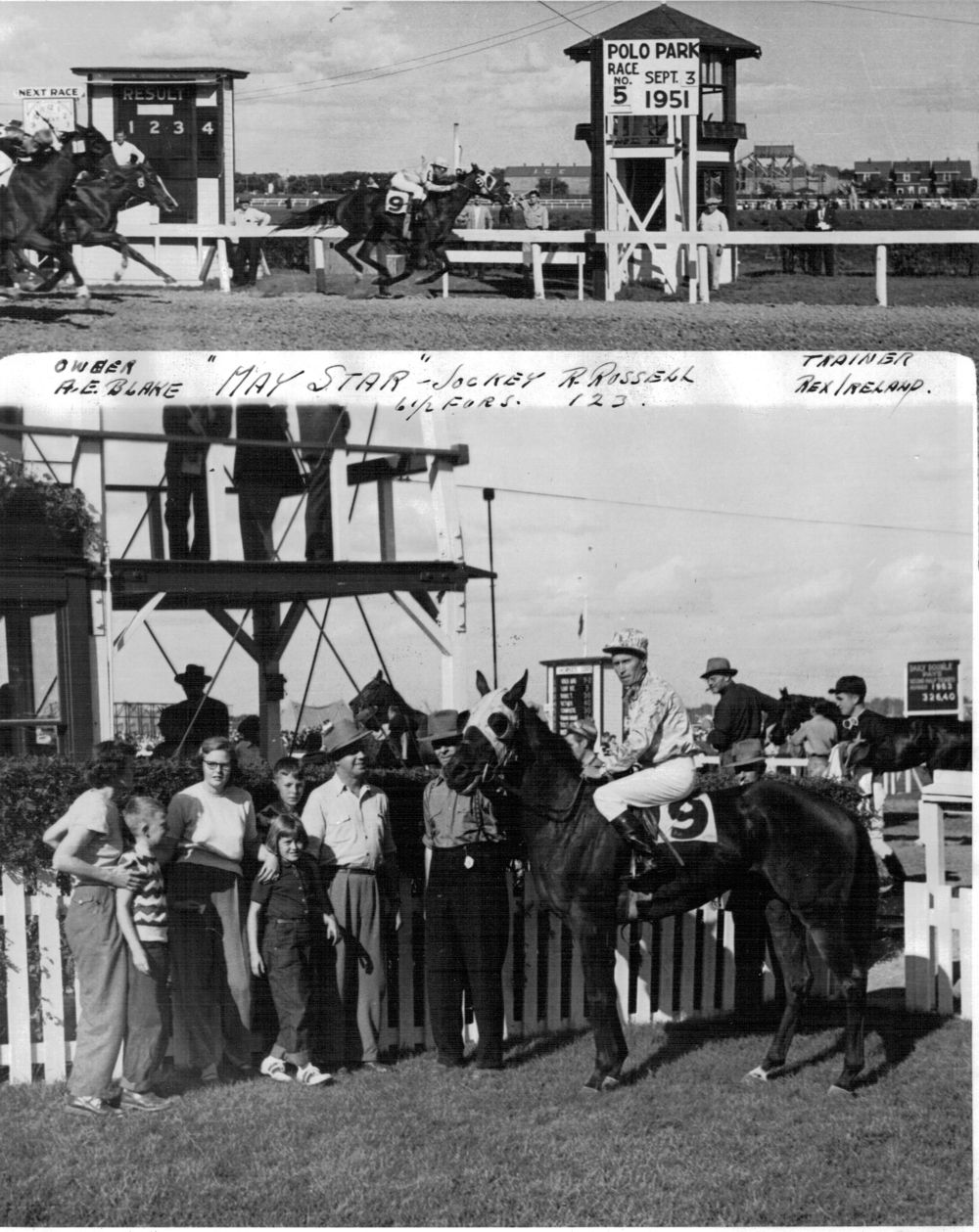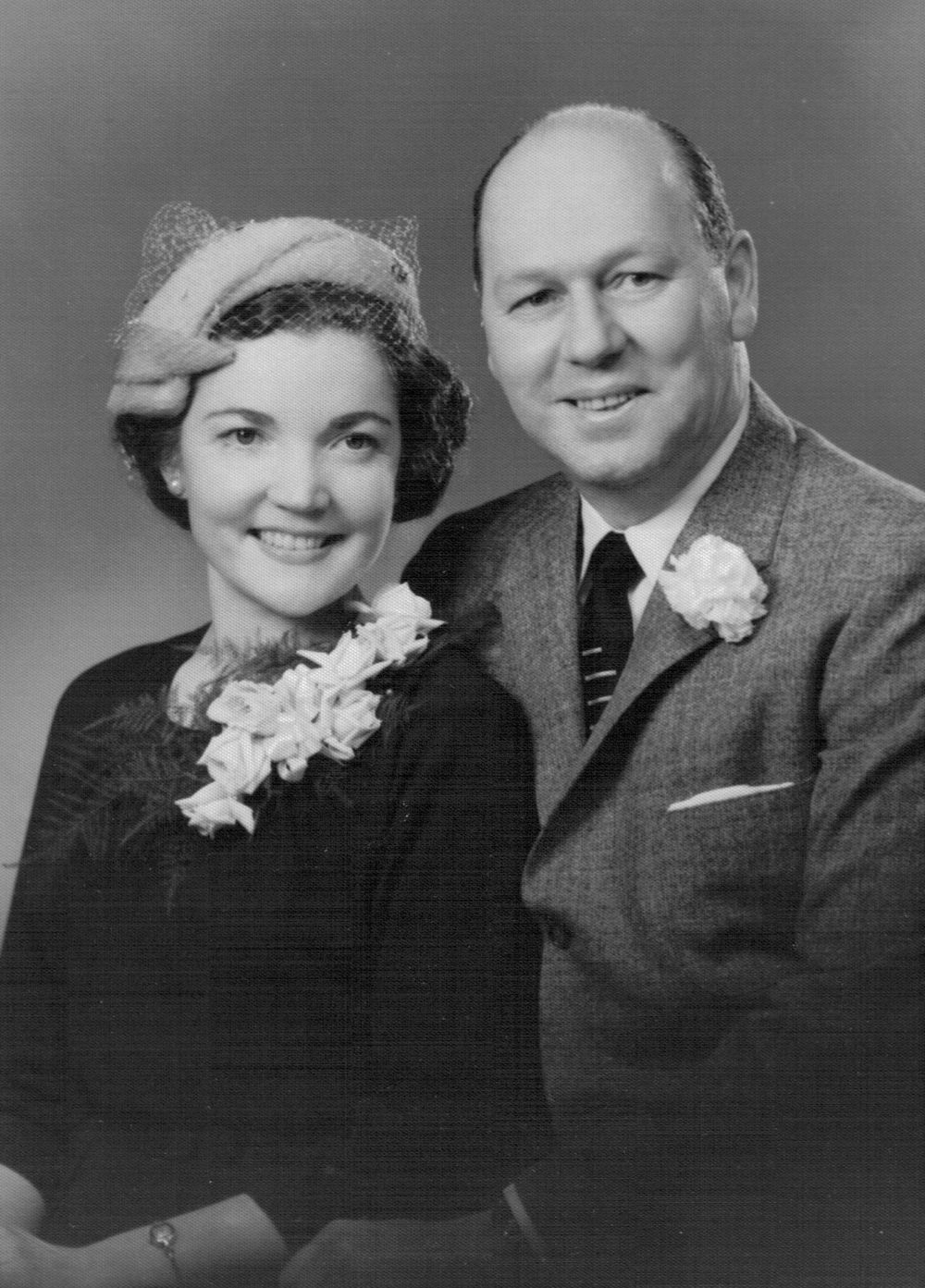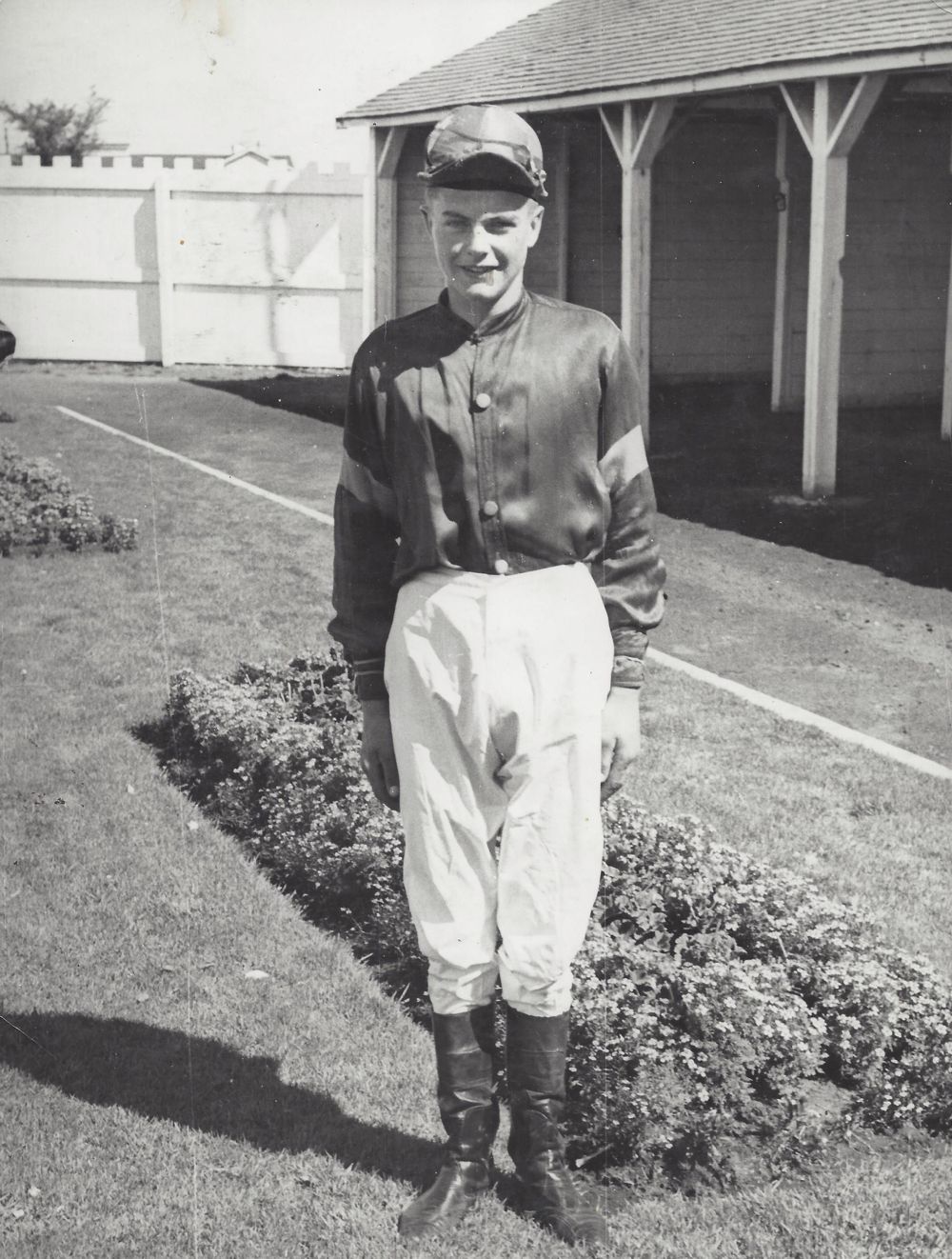Jockey Ray Stewart, a native of Gladstone, Manitoba, seen here in Calgary, 1950 (Ray Stewart family)
By Track Historian Bob Gates
A funny thing happened on the way to this week’s tale of the turf—the original idea was set aside, thanks to a chance discovery. The title of our story gives little away about where our horse racing time tunnel is taking us. Rest assured, the Marx Brothers’ 1937 film A Day at the Races isn’t relevant, nor will Queen’s 1976 studio album of the same name be of any help.
The inspiration lies buried in a monster pile of loosely gathered newspaper articles, handwritten notes, photographs, and assorted other research materials waiting to be sorted. Near the top of this unorganized mess was an old program from Polo Park, dated June 26, 1950.
That nearly 75-year-old program proved too tempting to ignore. There’s something special about milestone anniversaries—25, 50, 75, or 100 years.
So you flip through the pages, hoping to find names that still resonate—hoping “generational amnesia” hasn’t erased our horse racing memories. It’s an interesting term, almost self-explanatory. A quick search reveals:
“Each generation gets passed to it some fractional amount of prior knowledge by the most immediate and alive generations, plus a bit more via the no longer existent generations that have, by design or happenstance, left their presence in other recorded means. This is like doing one of those fire drills where you hand a bucket of water from one person to the next, each time slopping some of the water out of the bucket. When the bucket gets to the end of the line, there might only be a fraction remaining.”

Polo Park program from June 26, 1950 (Bob Gates)
Let’s turn our attention to Monday, June 26, 1950. It was the eighth day of the Winnipeg Jockey Club’s 14-day meet at Polo Park racetrack. Not that anybody asked, but the program had a handwritten note attached: “Gift from A. E. ‘Bert’ Blake – 2009,” which makes it extra special.
June figures prominently in the memories of Bert and Eileen Blake. On June 19, 2012, Mr. Blake passed away from a heart attack, just ten days short of his 93rd birthday. Two weeks later, Eileen joined her beloved Bert. They were together again—the way it was always meant to be.
It’s hard to separate memories of the Blakes from a look back at June 26, 1950. Let us not forget that Winnipeg and the surrounding areas had been hit hard by the raging floodwaters earlier that spring.
Who knew? Polo Park’s General Manager, R. James Speers, had pledged: “All profits of this 14-day meeting will be given to the Manitoba Flood Relief Fund.”
Most of the officials listed on the program’s front page were no surprise, but one name stood out. Dr. E. N. Anderson was the Veterinary Surgeon. Dr. Norm Anderson, father of former jockey Jimmy Anderson, was a pioneer in veterinary medicine in Manitoba and served as the Downs’ track vet for many years. “Doc” passed away in 1991.

L to R Lou Davies, Jim Speers and Dr. Norm Anderson at the 1st Horsemen's Ball circa 1951 (HBPA)
To be honest, few of the thoroughbred entries from that day looked familiar. Bert Blake saddled May Star in the third race, but she could only manage a fourth-place finish. The day’s winners included: Mataco, Long Dann, Scapa Blow, Just Rusty, Stoney Way, Major Slam, and Dark Colores.

Bert Blake's May Star, September 3, 1951 (Blake family)
As for the owners, a few names were easier to recall: Les Lear (Calgary), Neil Campbell (Calgary), Whittier Park Stock Farm (Jim Speers, Winnipeg), Bill Yates (Calgary), Jimmy Charlesworth (Edmonton), and Meadowbrook Stables (Max Freed, Winnipeg). Trainers included Joe Wynant, Dick Carey, Lorne Dupont, Bob Watt, Duke Campbell, Charlie Smith, and Billy Trevenen. Jockeys included Roy Johnson, Ray Stewart, Cliff Potts, and Anthony Licata.
Who knew? Anthony Licata was the father of Frank Licata, who rode at the Downs in the 1980s and ’90s.
Also, all ten of the leading riders on the Prairie Circuit rode that day: Emil Roy, Wayne Stevens, Richard Chew, Stan Connell, Roy Russell, Don Miller, George Godley, Jimmy Schmied, Rex Leavitt, and Jimmy Sivewright.
There were only two exotic wagers at the time: the Daily Double on races one and two, and a Quinella in race seven. But the rules for the Daily Double were a bit different in 1950:
“Ask ONLY for the post position number of the horse that you have elected to win the FIRST half of the Daily Double – SEE THAT YOUR TICKET BEARS THE RIGHT NUMBER.
IF THE HORSE YOU HAVE SELECTED DOES NOT WIN RACE NO. 1 – FIRST HALF OF THE DAILY DOUBLE – YOU ARE KNOCKED OUT OF THE POOL.
Should there be no tickets sold on the winner of the first half, those holding tickets on the horse finishing nearest the winner shall exchange tickets for their choice in the second half. Winning tickets from the first half must be exchanged by five minutes before the post time of the second half race.”
The seven-race card offered a total of $7,200 in purses—six races at $1,000 each and one at $1,200. It wasn’t unusual to see a field of $1,000 claimers racing for a $1,000 purse.
The Monday twilight card had a 5:00 p.m. post time. The track was rated “Heavy” after heavy weekend rains. The six-and-a-half furlong opener clocked in at 1:34—almost 15 seconds off the track record!
Race seven went to post at 8:09 p.m., with plenty of good old prairie daylight saving sunshine still in the sky. That six-and-a-half furlong race was run in a “sharp” 1:30 4/5—only 11 seconds off the record. The 2–3 quinella paid a tidy $64.35 on a $2 ticket.
All in all, a good day at the races—one that might have pleased Groucho and his brothers… and maybe even Freddie and his bandmates.

Mr. and Mrs. Blake (Blake family)
One final thought: thank you, Mr. Blake, for the program from June 26, 1950 . . .
A day at the races—75 years ago!

